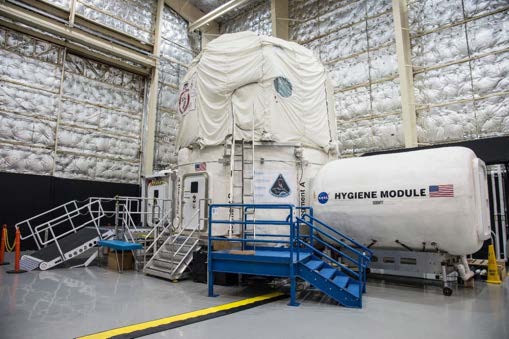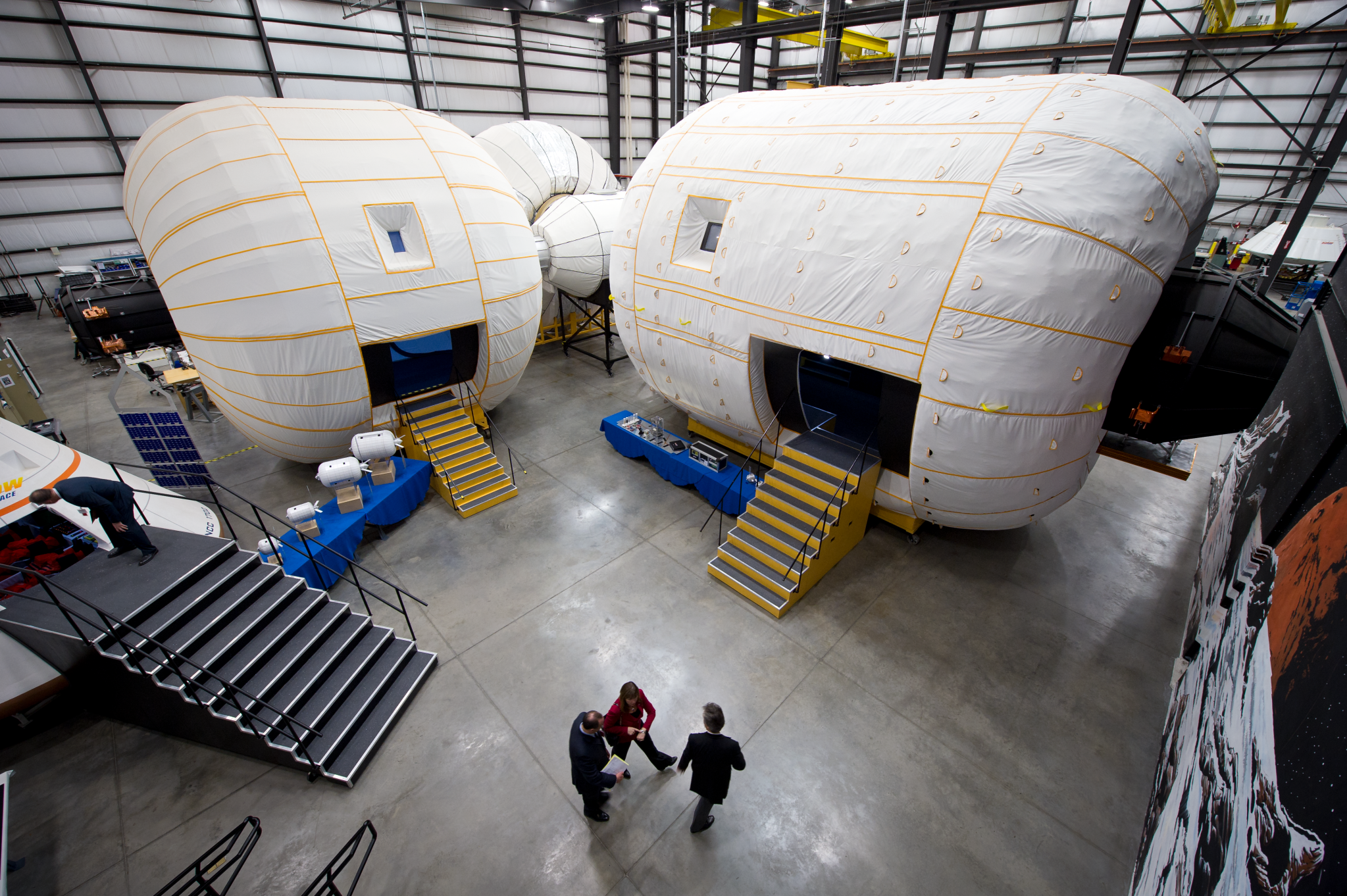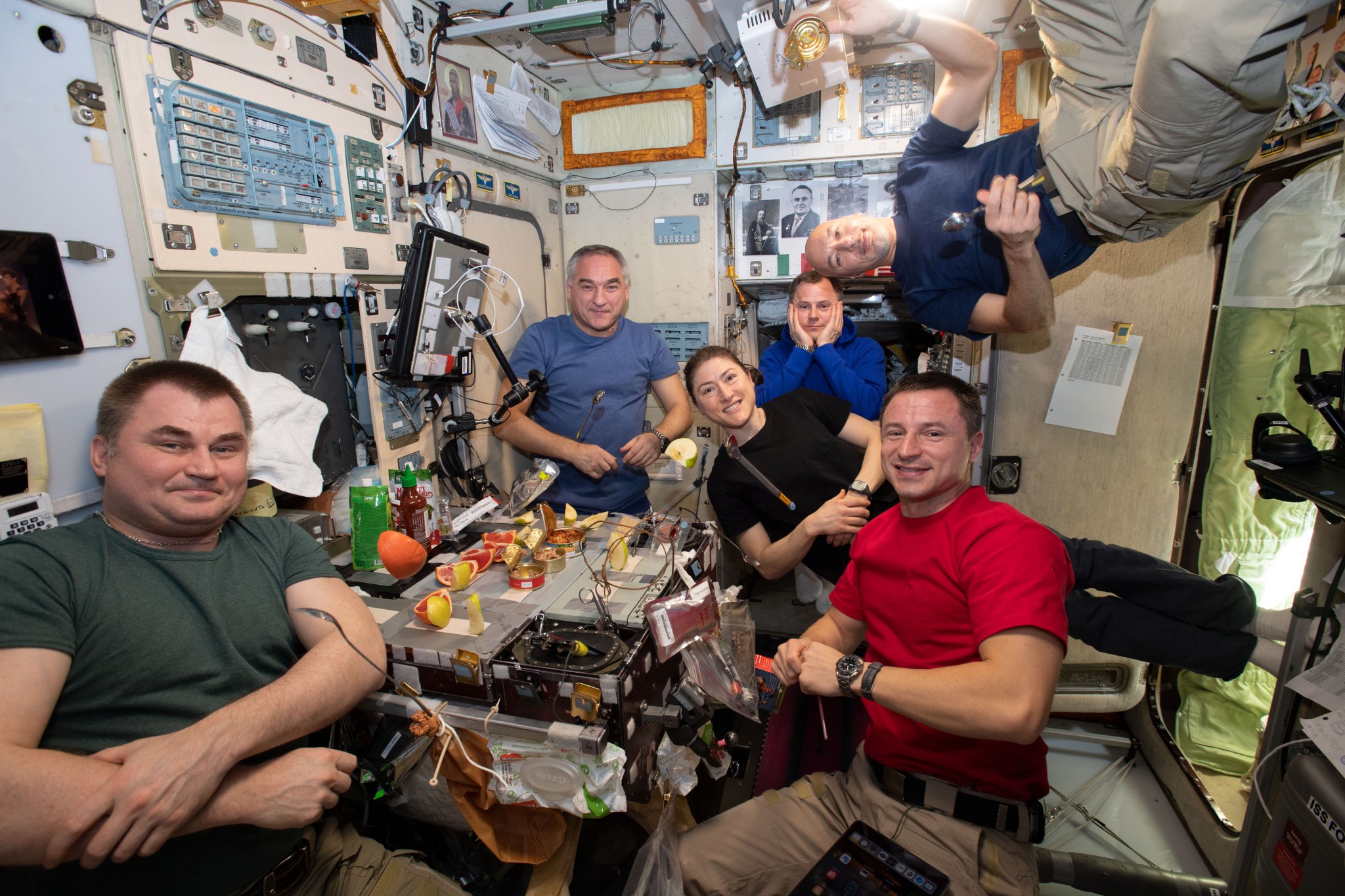Surface Habitats

Introduction
Johnson Space Center (JSC) is a world leader in design, development, testing and verification of habitation systems utilized to support astronauts living and working comfortably and safely in space. JSC covers the full life cycle of engineering spaceflight hardware from defining the problem, to research and design, rapid prototyping and development, to testing and operational support. From expertise and capabilities in human research, and human factors and performance, to spacecraft subsystems and other human subsystems, JSC provides everything necessary for a successful space habitat. We invite collaborators to join forces with us, leveraging our extensive and diverse capabilities in surface habitats to pioneer groundbreaking advancements in space exploration and enabling human presence on other planetary bodies.
Habitat Structure
Inflatable Habitable Elements
Overview | Inflatable Habitable Elements expertise is available for successful design, modeling, analysis, and testing of in-space & surface inflatable habitats.
Details |
- Design, modeling, analysis, and testing of in-space & surface inflatable habitats (modules, transfer tunnels, airlocks) expertise
- Analytical Simulation/Prediction, Independent Modeling and Model Validation
- Standards and Specifications Development
Spacecraft Glass & Windows
Overview | On-site expertise is available for successful design, modeling, analysis, and testing of spacecraft windows. Also, includes the Window Material Database that is used to characterize window materials for the spaceflight environment in a standardized way to facilitate window design trades.
Details |
- Standardized processes, procedures, facilities, personnel and material thicknesses (0.5”) will be used for characterization
- Allows for an apples-to-apples comparison between performance parameters for different materials
- Data is collected by objective NASA personnel
- No concerns for mismatched testing methodologies between materials
- No concerns for supplier creative marketing departments
- Enables designers to pursue innovative and integrated window subsystem designs and to optimally match mission requirements to window materials
- Will enable challenging future mission scenarios such as long duration habitats
- Will enable lightweight window subsystems
- Spaceflight relevant environments will be applied to characterize material performance, with parameters chosen based upon window design requirements needs
- The database is intended to be publicly released for use in the spaceflight industry
- Data will be stored in a publicly accessible database
- In the interim (while data is being developed), data will be made available to designers upon request
Softgoods and Materials Assessment
Overview | The Softgoods Lab, under the supervision of the Engineering Design and Analysis Branch, designs, develops, and manufactures flight softgoods components. They also design and fabricate ground support, test, and prototype softgoods. The designers collaborate with project engineers to define the requirements for EVA and IVA projects and establish specifications to fulfill them.
Details | The focus of the lab is developing customers’ needs and ideas into prototypes, which are then evaluated and customized to produce flight items that meet or exceed their requirements. The Advanced Materials Lab provides testing for developing & evaluating these materials for NASA & industry applications. This lab is equipped to evaluate materials, including textiles, coated structures, polymer films, foams, elastomers, papers, & adhesives.
Formulation & Analogs
Center for Design and Space Architecture
Overview | The Center for Design and Space Architecture (CDSA) is NASA’s conceptual, human centered design studio. They leverage skill in architecture and industrial design to provide customers with functional, intuitive solutions that synchronize with the integrated system.
Details | The CDSA employs an iterative design process and utilizes a variety of digital and physical mediums, including Computer-aided drafting (CAD), virtual reality, and full-scale mockups, to quickly progress design maturity for human spaceflight systems.
- Space Architecture: interior architecture, mission architecture, functional allocation, volumetric analysis
- Design: concept development, CAD modeling, mass and volume estimation, rendering, mockup, and prototype design
- Virtual Reality: design review and evaluation, task simulation, crewed human-in-the-loop (HITL) testing
- Prototyping: 3d printing, CNC, foam core, polycarbonates, wood, metal
- Mockups: part-task, full-scale, test articles, functional prototypes
Human Exploration Research Analog
Overview | Human Exploration Research Analog (HERA) is a unique three-story habitat designed to serve as an analog for isolation, confinement, and remote conditions in exploration scenarios.
Details |
- Mission Control Center (MCC) for real-time interaction with HERA crew members
- 24/7 mission video surveillance with audio, recorded during mission
- Communication delay, voice and/or text, up to 20 minutes each way
- Simulation of Acquisition of Signal/Loss of Signal of varying duration
- Individual crew sleeping quarters for 4 crew members
- HERA-provided Windows-based laptops and iPads for each crewmember for investigator data collection
- Flight Simulators to support an exploration mission scenario
- Virtual reality simulation for simulated EVA tasks
- Biological sample collection pre, during and post mission
- Medical Workstation (Remote medical procedures and examinations)
- Adjustable LED lighting on L2
- Simulated stowage module (pass through for hardware, biological samples, and trash)
- Modifiable virtual window views
- Exercise equipment (aerobic and resistive) to simulate daily operational activities
- Heart Rate Monitor to support exercise or research
- Actigraphy
- Simulated Environmental Control and Life Support System (ECLSS)
- 3D printer to support vehicle maintenance and operational tasks
- Flight-similar galley capabilities for preparing meals (plumbed water supply)
- Shower/sink with hot and cold running water for crew hygiene
Human Exploration Cross-Program Integration
Overview | Within the Exploration Architecture, Integration and Science (EAIS) Directorate at JSC, the Exploration Development Integration Division (EDI) provides expertise in integrating complex human spaceflight programs across common missions and architectures.
Details | The Exploration Development Integration Division (EDI) delivers systems engineering, cross-program integration, and operations integration support to the entire Moon to Mars enterprise, supporting all Artemis programs. EDI supports design, development and operational life cycle activities and provides integration in support of the Artemis Missions and the Moon to Mars enterprise.
- Orion cross-program integration and crew systems integration
- Gateway risk management and human rating support
- Human Landing System (HLS) cross-program integration and leadership of the Crew Compartment Program Office
- Moon to Mars System Engineering and Integration support
Human Exploration Program Formulation
Overview | Within the Exploration Architecture, Integration and Science (EAIS) Directorate at JSC, the Exploration Development Integration (EDI) Division, provides expertise to human space flight programs for systems and program integration activities supporting program formulation, design, development, and operational life cycle activities.
Details | The Exploration Development Integration Division (EDI) delivers systems engineering, cross-program integration, and operations integration support to the entire Moon to Mars enterprise, supporting all Artemis programs. EDI supports design, development and operational life cycle activities and provides integration in support of the Artemis Missions and the Moon to Mars enterprise.
Human in the Loop Testing and Analog Mission Planning and Execution
Overview | The Exploration Mission Planning Office (EMPO) at NASA JSC provides organizational expertise for analog mission planning and execution and integration of operational testing for space exploration. Human-in-the-loop (HITL) testing develops and assesses systems, innovations, and operational approaches to inform strategic architectural concept of operations decisions.
Details | The Exploration Mission Planning Office at NASA JSC provides analog mission planning and execution of integrated operational testing for space exploration. Human-in-the-loop (HITL) testing capabilities include establishing and coordinating a multi-disciplinary approach for operational testing, integrating analysis and development components across NASA, and using the results of testing in relevant environments for closing technology, exploration, and science knowledge questions, gaps, and risks.
Lunar Mission Architecture
Overview | The Lunar Architecture Team (LAT) defines lunar conceptual reference missions, architectures, and assessment of alternatives, as well as key performance parameters needed for lunar orbital and surface missions.
Details |
- Define conceptual and reference missions for lunar environments
- Define lunar mission architecture and perform alternative assessments
- Lunar mission timeline and site planning
- Develop and refine both crewed and uncrewed activities on the moon for future missions to include concept of operations, timeline development, and site planning
- Develop conceptual white papers to define and document NASA approaches to lunar architecture
Mars Campaign Architecture
Overview | The Mars Architecture Team (MAT) is responsible for developing human Mars conceptual reference missions, architectures, and assessment of alternatives that provide the future mission context needed to assess Mars-forward extensibility and commonality.
Details |
- Define human Mars conceptual reference missions, architecture, and alternative assessments
- Define mission elements and performance parameters for crewed Mars missions
- Identify technology gaps and associated decision points related to Mars architecture
- Define Mars analog needs on Earth, ISS, Gateway and the lunar surface
- Develop and refine the crewed and uncrewed activities on Mars for future missions
- Determine functional allocations for Mars elements
- Identify challenges/disconnects related to the Mars architecture
- Develop Architecture Concept Review (ACR) documentation
- Provide information and analyses to support evolving Agency and Exploration Systems Development Mission Directorate (ESDMD) strategic planning, including Artemis extensibility to Mars
Human Systems
Habitability Systems and Flight Crew Equipment
Overview | JSC personnel have the unique experience and vast knowledge of the technical challenges associated with metabolic waste management, personal hygiene, crew accommodations, galley hardware, trash management and odor control, logistics reduction and tracking, advanced clothing, housekeeping, tools and diagnostic equipment, restraints and mobility aids and unique stowage solutions.
Details |
- Habitability systems and flight crew equipment hardware development
- Performance requirements and concept of operations development
- Prototype development including use of rapid manufacturing and 3D printing
- Fabrication, assembly, and testing
- Technology demonstrations
- Certification and integration support
- Pre-flight inspections, checkouts, packing and delivery for launch
Crew Exercise On-Orbit Systems Management
Overview | JSC is the world leader for providing sustaining engineering and systems management for exercise devices.
Details |
Exercise Flight Systems Operations
- Data collection and analysis
- Life tracking, sparing inventory and manifesting
- Preventive and corrective maintenance plans and procedures development
- Risk management
- In-flight anomaly investigation, troubleshooting and resolution
- Flight readiness assessments
Device Sustaining Engineering and Systems Management on ISS
- Treadmills (TVIS and T2/COLBERT)
- Bike (CEVIS)
- Resistive Exercise (IRED and ARED)
- Health Monitoring (BP/ECG and Heart Rate)
- Vibration Isolation and Stabilization (VIS)
Integrated Mobile Evaluation Testbed for Robotics Operations (iMETRO)
Overview | iMETRO is designed to catalyze the adaptation of advanced terrestrial robotic technologies for space exploration use cases, such as logistics, maintenance, and science utilization within environments designed for human exploration on the Lunar and Martian surfaces. The iMETRO focus is on Intra-Vehicular Activity (IVA) environments, such as surface habitats, pressurized rover cabins, and space station internal modules. The iMETRO goal is to increase the availability of end-to-end systems enabling remote operation of robots in space supervised by humans on Earth. These systems include ground control user interfaces and software for managing robot remote control with realistic latency, bandwidth, and coverage interruptions for various mission environments (e.g., Low Earth Orbit, cis-Lunar, Lunar Surface, Mars Surface).
Details |
iMETRO Virtual and Physical Components
- The virtual facility includes open-source robot configurations (e.g., URDF) for iMETRO robots as well as models of mock-ups for space use cases, such as the crew access hatch and logistics stowage task trainer.
- The physical facility consists of a range of facility features and robot options. A variety of mock-ups and task trainers are available, and additional customized mockups can be designed and constructed by JSC staff for mission scenarios as needed.
Facility Features
- ROS2 compatible software interfaces
- Frame-mounted PTZ cameras
- Remote operator situational awareness
- Optical tracking ground truth for pose estimation and navigation
- Isolated robot network with configurable latency and bandwidth restrictions (currently a future planned capability)
iMETRO assets
- Mobile
- Relocatable
- Work with other facilities and larger mockups
- Gravity offload facility (ARGOS)
- Extra-vehicular robot facility (eDMT)
- Robots working inside large mockups in the adjacent high bay
Robot Options
- Linear rail-mounted single manipulator (available now)
- Universal Robots UR10e
- Robotiq hand-E Gripper w/ Custom Fingers
- Vention horizontally mounted 2.0m linear rail
- Ewellix Telescoping Lift Kit with 700mm Stroke
- Intel® RealSense™ Wrist-Mounted Depth Camera
- Mobile Base Dual Manipulator (coming in 2024)
- Universal Robots UR5e (2x)
- Robotiq Hand-E Grippers with Custom Fingers
- Arms mounted to dual, independent lift-kits of 500mm Stroke
- Clearpath Ridgeback Wheeled Mobile Base
- Intel® RealSense™ Wrist-Mounted Depth Cameras
- Bring Your Own Sensors and/or End Effectors
- Utilize standard interfaces
- Bring Your Own Robot
- Test custom configurations with iMETRO space application mock-ups and end effectors
Systems Engineering Simulator (SES)
Overview | The Systems Engineering Simulator (SES) provides immersive, human-in-the-loop simulations of NASA vehicles. These simulations utilize realistic cockpits that are typically installed within a dome visual system and paired with engineering-fidelity models of the vehicle systems and the space environments in which they operate. These simulations are utilized for all phases of a space mission, from early conceptualization through system development, mission planning, training, and operations.
Details |
- Two dome visual systems, one containing an ISS cupola mockup and the other containing an Orion mockup (either upright or reclined)
- Six-Degrees-of-Freedom (6-DOF) motion table for simulating Artemis assets, including rovers and landers
- Video wall containing reconfigurable cockpits for assessing advanced concept vehicles
- Math modeling of space vehicles and the environments in which they operate
- Study/training support to develop initial conditions, verify scenarios, support operations, and post-process data as needed
- Real-time maintenance support to resolve issues with minimal downtime


































